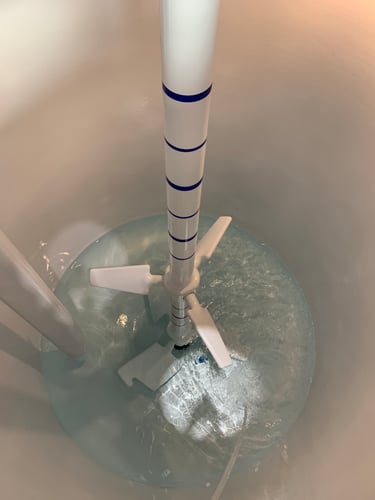Optimizing Low-Level Mixing in Process Vessels: Challenges and Solutions
 In the world of chemical processing, pharmaceutical manufacturing, and even food and beverage production, the ability to effectively mix small volumes of materials in process vessels is crucial. Low-level mixing presents a unique set of challenges that can significantly impact product quality, consistency, and production efficiency. However, advancements in mixing technology and strategic approaches have provided a pathway to overcoming these obstacles. In this post, we'll explore the complexities of low-level mixing in a glass-lined vessel, the technologies available to optimize this process, and the solutions that can help ensure success.
In the world of chemical processing, pharmaceutical manufacturing, and even food and beverage production, the ability to effectively mix small volumes of materials in process vessels is crucial. Low-level mixing presents a unique set of challenges that can significantly impact product quality, consistency, and production efficiency. However, advancements in mixing technology and strategic approaches have provided a pathway to overcoming these obstacles. In this post, we'll explore the complexities of low-level mixing in a glass-lined vessel, the technologies available to optimize this process, and the solutions that can help ensure success.
Challenges of Low-Level Mixing
Low-level mixing in process vessels refers to the mixing of materials when the liquid level is relatively low compared to the size of the mixing vessel. (To be clear, if the process is below the baffle(s) basically it is stirring. The mixing starts as the process confronts the baffle.) This scenario poses several challenges:
- Inefficient Mixing: Traditional impellers may not be submerged adequately, leading to poor mixing efficiency and uneven distribution of components.
- Formation of Vortices: Low liquid levels can lead to the formation of vortices, which can introduce air into the mix, affecting product quality.
- Product Loss: In processes where every drop counts, the inability to mix effectively at low levels can result in significant product loss and waste.
- Scaling Issues: Translating mixing processes from small-scale laboratory settings to larger production volumes can be problematic when dealing with low-volume mixes.
Technologies and Solutions for Optimizing Low-Level Mixing
To address these challenges, various technologies and strategies have been developed:
Specialized Impellers and Agitators
- Scaba Side-Mounted Agitators: These are designed to work effectively in low-level conditions, minimizing vortex formation and ensuring thorough mixing without introducing air into the mix.
- Magnetic Mixers: For ultra-clean or sterile environments, such as pharmaceutical manufacturing, magnetic mixers offer efficient low-level mixing with minimal risk of contamination.
- OptiFoil Blades: OptiFoil, the newest design of GlasLock blades from De Dietrich, combines the advantages of HydroFoil blades and Trapezoidal blades for optimized mixing. OptiFoil takes the features of these two designs and brings to the market a solution that ensures a high axial flow for suspension processes and facilitates the operation of minimum volumes. The pitch angle of these blades gives a smoother contact with the product than the vertical trapezoidal blades and is specifically recommended to avoid the alteration of fragile crystals.
Tank Design Modifications
- Baffling: Adding baffles to the mixing vessel can prevent the formation of vortices and improve mixing efficiency by creating more turbulence.
- Conical Bottom Tanks: Tanks designed with a conical bottom can facilitate more effective mixing of small volumes, ensuring that the liquid is directed towards the impeller.
Advanced Control Systems
- Automated Feedback Systems: These systems can adjust mixing speed and power in real-time based on viscosity changes or the incorporation of solid materials, ensuring consistent mixing even at low levels.
- Load Cells and Level Sensors: By accurately measuring the weight and level of the materials in the vessel, these technologies help optimize the mixing process, reducing waste and improving efficiency.
Scale-Down Models
- Developing accurate scale-down models allows for precise scaling of mixing processes from the laboratory to production scale, ensuring that low-volume mixing can be effectively replicated and scaled up.
The challenges of low-level mixing in process vessels are significant but not insurmountable. Through the adoption of specialized impellers and agitators (like OptiFoil), modifications to tank design, advanced control systems, and accurate scale-down models, manufacturers can overcome these obstacles. These technologies not only optimize the mixing of small volumes but also enhance product quality, reduce waste, and improve production efficiency. As the industry continues to evolve, staying abreast of these advancements and understanding how to apply them effectively will be key to success in any field requiring precise mixing processes.
In need of more agitation expertise? Take our Agitation Questionnaire or contact us with details of your process issue for professional help.
